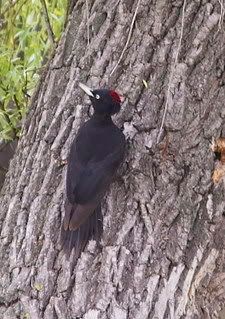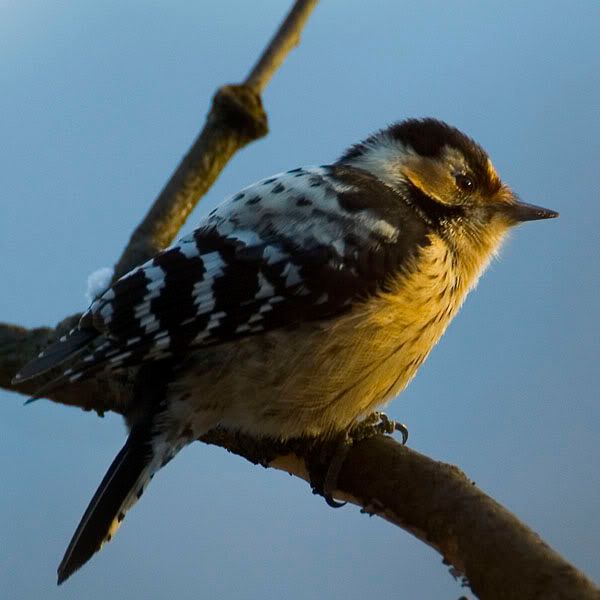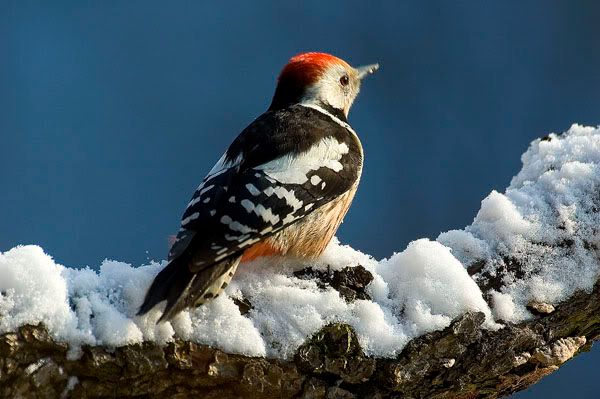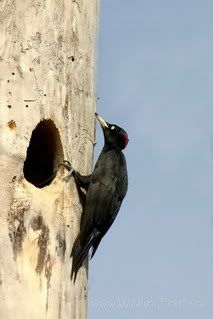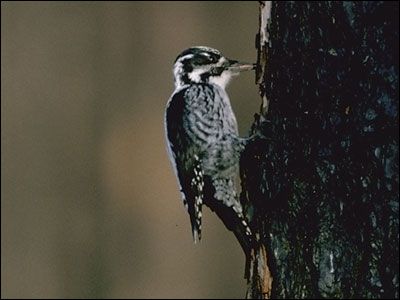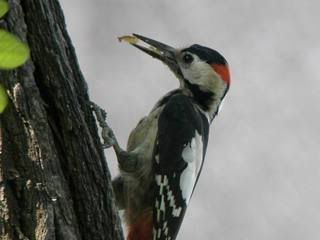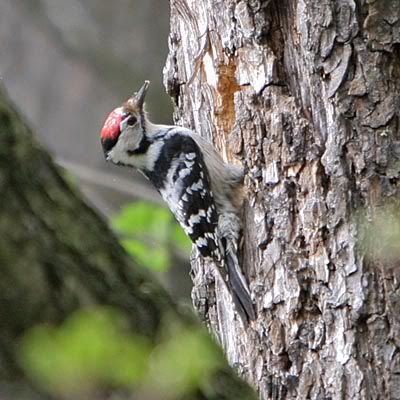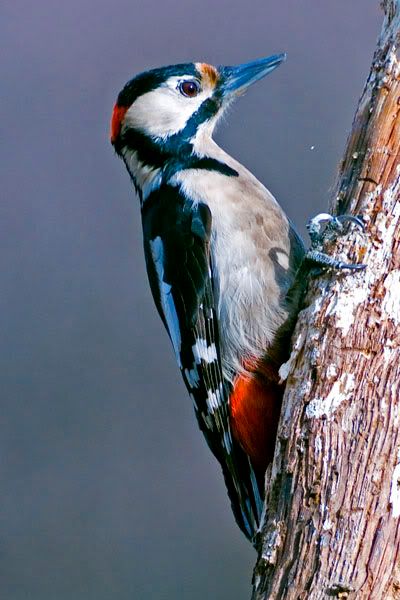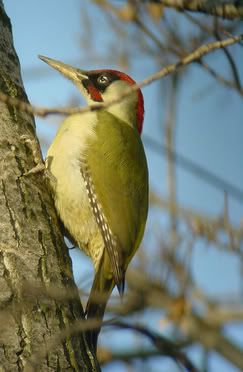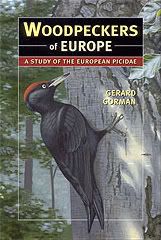 This photo taken recently by Szabolcs Kokay in Budapest, Hungary, shows a male Great Spotted Woodpecker Dendrocopos major with atypical head markings. It can be seen that the post-aurical stripes do not fully join at the nape, they are broken. This may suggest Syrian Woodpecker Dendrocopos syriacus or perhaps a hybrid bird. However, other features such as the red undertail coverts and strong beak indicate Great Spotted. The bird also apparently called like a Great Spotted and had considerable white on the outer tail feathers (though not really visable on this shot). Such birds often cause observers to claim a hybrid Great Spotted-Syrian, however such atypical features are not uncommon on Great Spotted Woodpeckers and I believe that this bird is simply an atypical specimen. Whether the bird has some Syrian influences, that is, a back-cross resultant from previous hybridizations, cannot be determined.
This photo taken recently by Szabolcs Kokay in Budapest, Hungary, shows a male Great Spotted Woodpecker Dendrocopos major with atypical head markings. It can be seen that the post-aurical stripes do not fully join at the nape, they are broken. This may suggest Syrian Woodpecker Dendrocopos syriacus or perhaps a hybrid bird. However, other features such as the red undertail coverts and strong beak indicate Great Spotted. The bird also apparently called like a Great Spotted and had considerable white on the outer tail feathers (though not really visable on this shot). Such birds often cause observers to claim a hybrid Great Spotted-Syrian, however such atypical features are not uncommon on Great Spotted Woodpeckers and I believe that this bird is simply an atypical specimen. Whether the bird has some Syrian influences, that is, a back-cross resultant from previous hybridizations, cannot be determined.
Tuesday, 30 December 2008
Atypical Great Spotted Woodpecker
 This photo taken recently by Szabolcs Kokay in Budapest, Hungary, shows a male Great Spotted Woodpecker Dendrocopos major with atypical head markings. It can be seen that the post-aurical stripes do not fully join at the nape, they are broken. This may suggest Syrian Woodpecker Dendrocopos syriacus or perhaps a hybrid bird. However, other features such as the red undertail coverts and strong beak indicate Great Spotted. The bird also apparently called like a Great Spotted and had considerable white on the outer tail feathers (though not really visable on this shot). Such birds often cause observers to claim a hybrid Great Spotted-Syrian, however such atypical features are not uncommon on Great Spotted Woodpeckers and I believe that this bird is simply an atypical specimen. Whether the bird has some Syrian influences, that is, a back-cross resultant from previous hybridizations, cannot be determined.
This photo taken recently by Szabolcs Kokay in Budapest, Hungary, shows a male Great Spotted Woodpecker Dendrocopos major with atypical head markings. It can be seen that the post-aurical stripes do not fully join at the nape, they are broken. This may suggest Syrian Woodpecker Dendrocopos syriacus or perhaps a hybrid bird. However, other features such as the red undertail coverts and strong beak indicate Great Spotted. The bird also apparently called like a Great Spotted and had considerable white on the outer tail feathers (though not really visable on this shot). Such birds often cause observers to claim a hybrid Great Spotted-Syrian, however such atypical features are not uncommon on Great Spotted Woodpeckers and I believe that this bird is simply an atypical specimen. Whether the bird has some Syrian influences, that is, a back-cross resultant from previous hybridizations, cannot be determined.
Sunday, 28 December 2008
Woodpecker anvil
 In this photo a Great Spotted Woodpecker Dendrocopos major is dealing with a pine-cone wedged in an anvil. An anvil like this is sometimes called a "smithy" or "workshop". An anvil is a place, usually a crevice or hole on a tree, but sometimes in a wall, where a woodpecker wedges a food item which it can then open up.
In this photo a Great Spotted Woodpecker Dendrocopos major is dealing with a pine-cone wedged in an anvil. An anvil like this is sometimes called a "smithy" or "workshop". An anvil is a place, usually a crevice or hole on a tree, but sometimes in a wall, where a woodpecker wedges a food item which it can then open up.
Friday, 19 December 2008
Gallery: Adult female Great Spotted Woodpecker
Wednesday, 17 December 2008
Monday, 15 December 2008
Gallery: Syrian Woodpecker adult female
 Adult female Syrian Woodpecker Dendrocopos syriacus. Pink undertail coverts, black outer tail feathers and lack of post-auricular stripe on the cheek indicate Syrian rather than Great Spotted Woodpecker. All black nape, lacking red, indicates a female. This photo taken by Julia Burton in Tiszafured, Hungary in October 2008.
Adult female Syrian Woodpecker Dendrocopos syriacus. Pink undertail coverts, black outer tail feathers and lack of post-auricular stripe on the cheek indicate Syrian rather than Great Spotted Woodpecker. All black nape, lacking red, indicates a female. This photo taken by Julia Burton in Tiszafured, Hungary in October 2008.
Friday, 12 December 2008
Gallery: Green Woodpecker juvenile male
Wednesday, 10 December 2008
Monday, 8 December 2008
Black Woodpecker: more feeding site signs
 Here is another example of a classic feeding site of Black Woodpecker. Large, long slits and oval-shaped holes, large woodchips on the ground below. Some holes close to the ground, too. The bird has hacked into the heart of the tree to feed on carpenter ants. Photo taken in the Buda Hills, Budapest, Hungary, December 2008.
Here is another example of a classic feeding site of Black Woodpecker. Large, long slits and oval-shaped holes, large woodchips on the ground below. Some holes close to the ground, too. The bird has hacked into the heart of the tree to feed on carpenter ants. Photo taken in the Buda Hills, Budapest, Hungary, December 2008.
Thursday, 4 December 2008
Gallery: Great Spotted Woodpecker adult male
Wednesday, 3 December 2008
Gallery: Three-toed Woodpecker adult male alpinus race
Monday, 1 December 2008
Woodpeckers hiding
 This photo of a Black Woodpecker shows the bird in a typical, classic pose. When approached many woodpeckers (if they do not fly off) will simply move to the opposite side of the tree trunk to the observer. From here they will occasionally peep out and assess the situation. This shot was taken by Szabolcs Kokay at Tata, Hungary.
This photo of a Black Woodpecker shows the bird in a typical, classic pose. When approached many woodpeckers (if they do not fly off) will simply move to the opposite side of the tree trunk to the observer. From here they will occasionally peep out and assess the situation. This shot was taken by Szabolcs Kokay at Tata, Hungary.
Sunday, 30 November 2008
Gallery: White-backed Woodpecker adult female lilfordi race
Friday, 28 November 2008
Gallery: White-backed Woodpecker adult male lilfordi race
Thursday, 27 November 2008
Tuesday, 25 November 2008
Black Woodpecker: fresh feeding site - woodchips
 This photo shows the woodchips below the feeding site of the Black Woodpecker shown in the previous post (below). The largest chips were about 4cm long. Due to the softness of the rotten timber at the heart of the trunk, many chips were soft and frayed. Photo taken near Subotica, Serbia, in November 2009.
This photo shows the woodchips below the feeding site of the Black Woodpecker shown in the previous post (below). The largest chips were about 4cm long. Due to the softness of the rotten timber at the heart of the trunk, many chips were soft and frayed. Photo taken near Subotica, Serbia, in November 2009.
Sunday, 23 November 2008
Black Woodpecker: fresh feeding site
 This close up shows the fresh feeding site of a Black Woodpecker. The bird was searching for carpenter ants which have their colonies inside tree trunks. The hole was some 30cm long by 16cm wide and 20cm deep (two adult hands could easily fit inside). Indeed the bird that made the hole must have been at times totally inside the hole when excavating it. Photo taken near Subotica, Serbia, in November 2009.
This close up shows the fresh feeding site of a Black Woodpecker. The bird was searching for carpenter ants which have their colonies inside tree trunks. The hole was some 30cm long by 16cm wide and 20cm deep (two adult hands could easily fit inside). Indeed the bird that made the hole must have been at times totally inside the hole when excavating it. Photo taken near Subotica, Serbia, in November 2009.
Monday, 17 November 2008
Friday, 14 November 2008
Recommended Reading:
Compared to most other bird families woodpeckers have not been widely written about. There are many ornithological studies but very few books on the Picidae for general reading. From those available one of the best is My Year With The Woodpeckers by Heinz Sielmann. This wonderful book deals mainly with Black Woodpeckers in Germany and how they were first filmed in the nesting cavity for BBC television in the 1950s. It is out of print but can be found in antiquarian book shops and on the internet. My English language copy dates from 1961 and was published by the Readers Union, London.
Wednesday, 12 November 2008
Great Spotted Woodpecker: atypical female
 These two photos of a Great Spotted Woodpecker Dendrocopos major were taken recently in Hungary by Szabolcs Kókay. The bird seems to be a female as a male would have a large red nape patch. But note that though this bird's nape is black, there are two spots of red on the nape. Juvenile Great Spotted Woodpeckers of both sexes have all red crowns and sometimes retain some red colour on the head after moulting into adult plumage, so it might be considered that this bird is a female that has just moulted from juvenile to adult plumage (see brown feathers on the wing in one photo) and which has retained some red feathers on the head. However, this would not explain why the red is on the nape, rather than on the crown. It might also be thought that this is an adult male that has a reduced amount of red on the nape. However, I consider this bird to be an atypical female. In fact, close inspection of Great Spotted (and other Dendrocopos woodpeckers) often reveals unusual, atypical plumages such as this.
These two photos of a Great Spotted Woodpecker Dendrocopos major were taken recently in Hungary by Szabolcs Kókay. The bird seems to be a female as a male would have a large red nape patch. But note that though this bird's nape is black, there are two spots of red on the nape. Juvenile Great Spotted Woodpeckers of both sexes have all red crowns and sometimes retain some red colour on the head after moulting into adult plumage, so it might be considered that this bird is a female that has just moulted from juvenile to adult plumage (see brown feathers on the wing in one photo) and which has retained some red feathers on the head. However, this would not explain why the red is on the nape, rather than on the crown. It might also be thought that this is an adult male that has a reduced amount of red on the nape. However, I consider this bird to be an atypical female. In fact, close inspection of Great Spotted (and other Dendrocopos woodpeckers) often reveals unusual, atypical plumages such as this.Monday, 10 November 2008
Friday, 7 November 2008
Feeding signs on a fir tree
Thursday, 23 October 2008
Gallery: Black Woodpecker nestlings
 Black Woodpeckers can be visually sexed when still in the nesting cavity, i.e. before they fledge. As with adults, fledgling males have complete red crowns whilst fledgling females only have red on the hind crown. Thus, the top bird in this photo is a male. The sex of the lower bird is unclear due to its crown being out of view.
Black Woodpeckers can be visually sexed when still in the nesting cavity, i.e. before they fledge. As with adults, fledgling males have complete red crowns whilst fledgling females only have red on the hind crown. Thus, the top bird in this photo is a male. The sex of the lower bird is unclear due to its crown being out of view.
Tuesday, 21 October 2008
Gallery: Black Woodpecker adult male
Sunday, 19 October 2008
Gallery: Black Woodpecker female
Saturday, 4 October 2008
Monday, 29 September 2008
Gallery: White-backed Woodpecker adult female
Tuesday, 23 September 2008
Wednesday, 17 September 2008
Monday, 15 September 2008
Friday, 12 September 2008
Thursday, 11 September 2008
Tuesday, 9 September 2008
Gallery: Black Woodpecker adult female
Monday, 8 September 2008
Gallery: Three-toed Woodpecker adult female
Sunday, 7 September 2008
Saturday, 6 September 2008
Wednesday, 3 September 2008
Gallery: White-backed Woodpecker adult male
Monday, 1 September 2008
Saturday, 23 August 2008
Gallery: Middle Spotted Woodpecker adult male
Wednesday, 20 August 2008
Gallery: Great Spotted Woodpecker adult male
Tuesday, 19 August 2008
Gallery: Grey-headed (Grey-faced) Woodpecker adult male
Monday, 18 August 2008
Wednesday, 13 August 2008
Tuesday, 12 August 2008
Gallery: Three-toed Woodpecker adult male
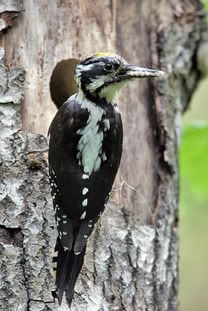 Adult male Three-toed Woodpecker Picoides tridactylus. Nominate race tridactylus. Taken in Estonia by Mati Kose. This is the first photograph in a series where I intend to show all 10 European woodpecker species in various plumages. Hopefully I will be able to include adult males, adult females, juveniles and where relevant geographical races.
Adult male Three-toed Woodpecker Picoides tridactylus. Nominate race tridactylus. Taken in Estonia by Mati Kose. This is the first photograph in a series where I intend to show all 10 European woodpecker species in various plumages. Hopefully I will be able to include adult males, adult females, juveniles and where relevant geographical races.
Monday, 11 August 2008
Quiz woodpecker 19
 Here is the latest quiz woodpecker photo. Here is a clue: the bird low down on the right is a Great Reed Warbler Acrocephalus arundinaceus and the bird top-left is the woodpecker. That bird is obviously a Dendrocopos species, being mainly "black and white" (a so-called "pied" woodpecker) and there are only 5 Dendrocopos species in Europe... so it should not be too difficult to narrow it down!
Here is the latest quiz woodpecker photo. Here is a clue: the bird low down on the right is a Great Reed Warbler Acrocephalus arundinaceus and the bird top-left is the woodpecker. That bird is obviously a Dendrocopos species, being mainly "black and white" (a so-called "pied" woodpecker) and there are only 5 Dendrocopos species in Europe... so it should not be too difficult to narrow it down!
Sunday, 3 August 2008
Friday, 1 August 2008
Woodpecker artwork: drawings
 In earlier posts on this blog I mentioned the work of Hungarian wildlife artist Szabolcs Kokay. Besides his excellent paintings of woodpeckers Szabolcs also draws and sketches the family. This fine black and white drawing of two Middle Spotted Woodpeckers Dendrocopos medius in an oakwood in Hungary, was published in my book Woodpeckers of Europe. Here, the artist's skill in capturing the jizz and behaviour of woodpeckers is clear. More of Szabolcs' work (woodpeckers and other birds and wildlife) can be seen here: http://kokayart.blogspot.com/
In earlier posts on this blog I mentioned the work of Hungarian wildlife artist Szabolcs Kokay. Besides his excellent paintings of woodpeckers Szabolcs also draws and sketches the family. This fine black and white drawing of two Middle Spotted Woodpeckers Dendrocopos medius in an oakwood in Hungary, was published in my book Woodpeckers of Europe. Here, the artist's skill in capturing the jizz and behaviour of woodpeckers is clear. More of Szabolcs' work (woodpeckers and other birds and wildlife) can be seen here: http://kokayart.blogspot.com/
Saturday, 26 July 2008
Vertical lines of woodpecker holes
 It is not unusual to see a vertical line of woodpecker holes on a tree. This is often the result of a pair of woodpeckers having created new nesting cavities in a favourite tree year after year. A favourite tree is one that has proved easy to excavate and which was successful for breeding. Sometimes such lines of holes are due to the birds having started a cavity and then abandoned it before moving on to another spot on the same tree trunk. It can also be the case that some of the holes in a line lead to the same, single cavity. That is, the cavity within the tree trunk has more than one entrance. But in this case, it is not clear whether this is by accident or by design. Woodpeckers also produce lines of holes when searching for tree dwelling prey. This example of a series of Black Woodpecker holes in a beech tree was taken by Szabolcs Kokay in the Zemplen Hills, Hungary.
It is not unusual to see a vertical line of woodpecker holes on a tree. This is often the result of a pair of woodpeckers having created new nesting cavities in a favourite tree year after year. A favourite tree is one that has proved easy to excavate and which was successful for breeding. Sometimes such lines of holes are due to the birds having started a cavity and then abandoned it before moving on to another spot on the same tree trunk. It can also be the case that some of the holes in a line lead to the same, single cavity. That is, the cavity within the tree trunk has more than one entrance. But in this case, it is not clear whether this is by accident or by design. Woodpeckers also produce lines of holes when searching for tree dwelling prey. This example of a series of Black Woodpecker holes in a beech tree was taken by Szabolcs Kokay in the Zemplen Hills, Hungary.
Tuesday, 22 July 2008
Tuesday, 8 July 2008
Wednesday, 4 June 2008
Black Woodpecker: identifying a feeding site
 Here is a photo of a feeding site of a woodpecker (taken this May in the Soomaa National Park, Estonia). Several things point to this being the work of a Black Woodpecker. Firstly, the size of the holes made (an adult's hand can easily fit inside), Secondly, the location (being at ground level, only Black, Green and Grey-headed are comfortable feeding with their feet on terra firma). Thirdly, the size of the wood chips (some 6cm long). And, though not really visible in this photo, the beak marks on the timber were very large, too large for any other European woodpecker species.
Here is a photo of a feeding site of a woodpecker (taken this May in the Soomaa National Park, Estonia). Several things point to this being the work of a Black Woodpecker. Firstly, the size of the holes made (an adult's hand can easily fit inside), Secondly, the location (being at ground level, only Black, Green and Grey-headed are comfortable feeding with their feet on terra firma). Thirdly, the size of the wood chips (some 6cm long). And, though not really visible in this photo, the beak marks on the timber were very large, too large for any other European woodpecker species.
Subscribe to:
Comments (Atom)















